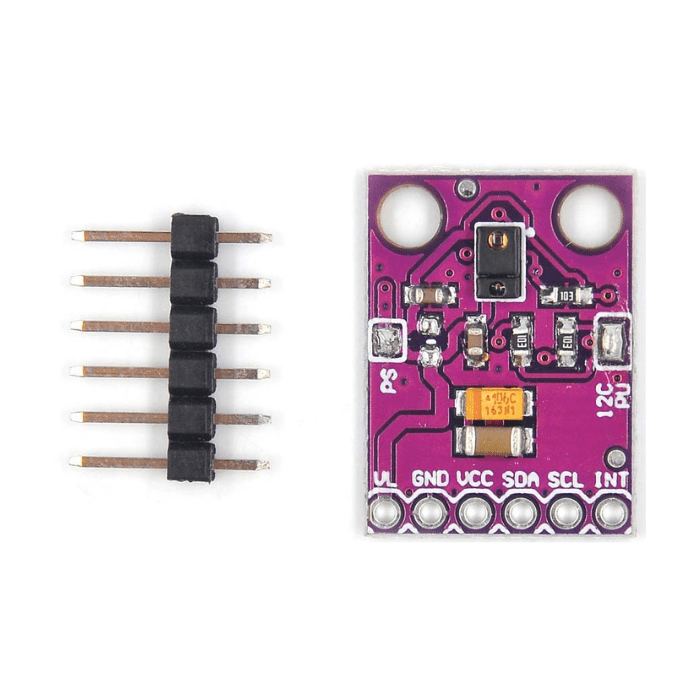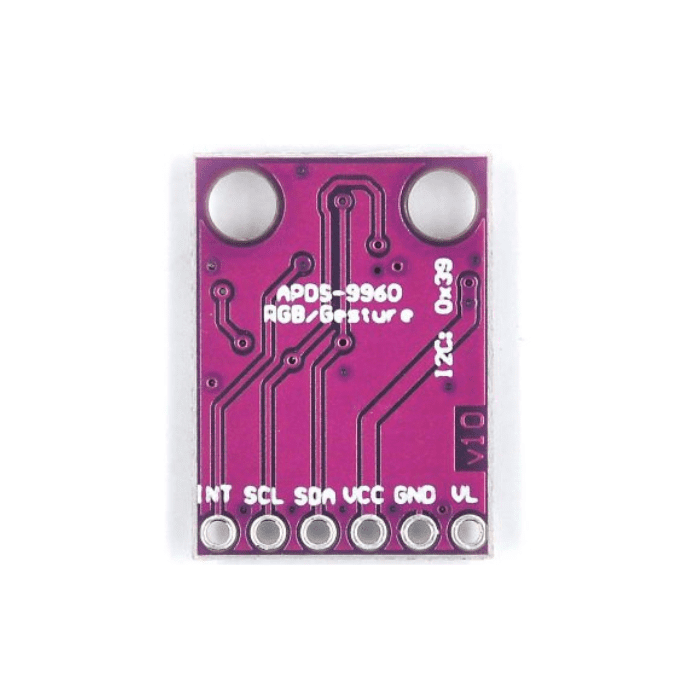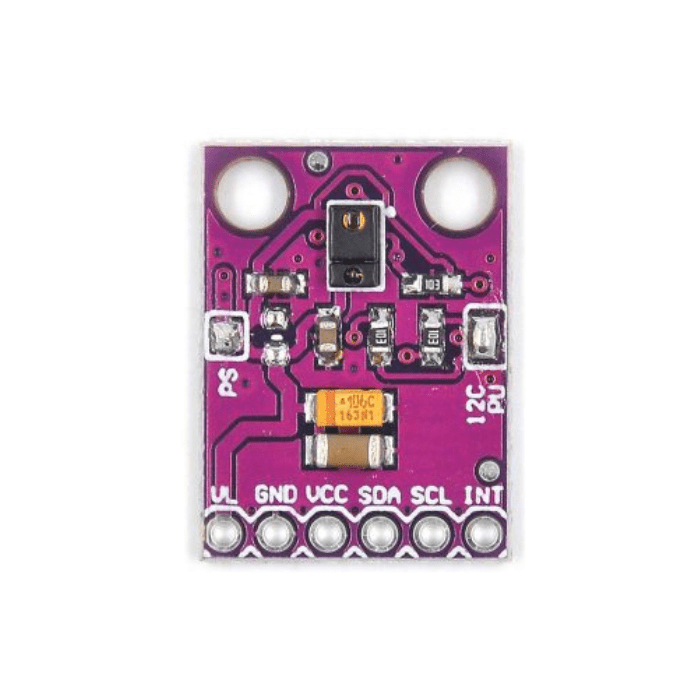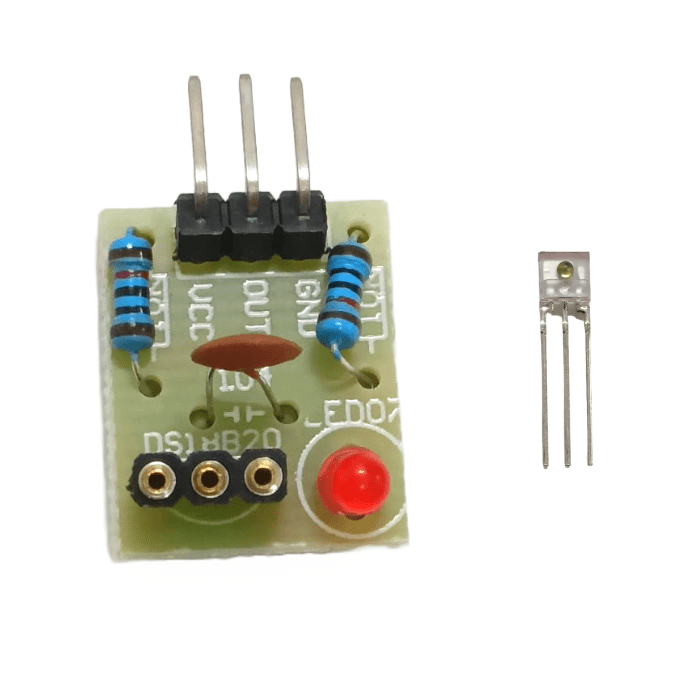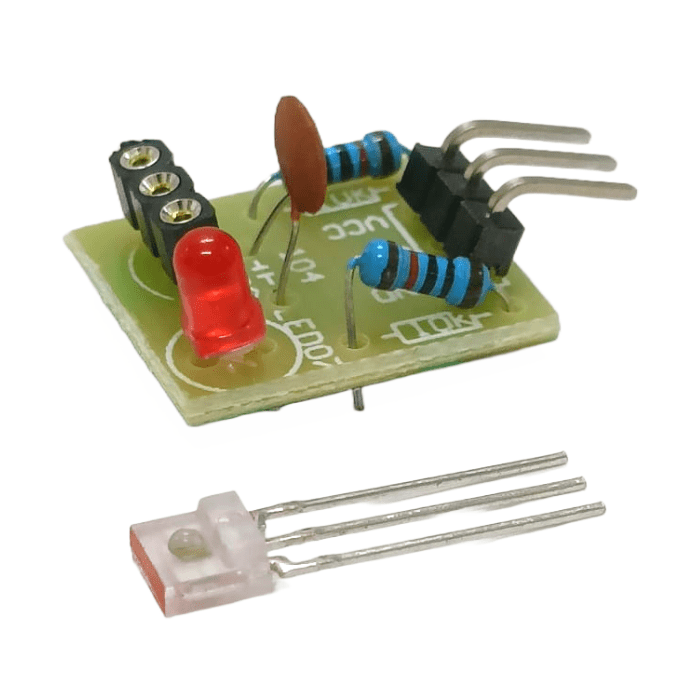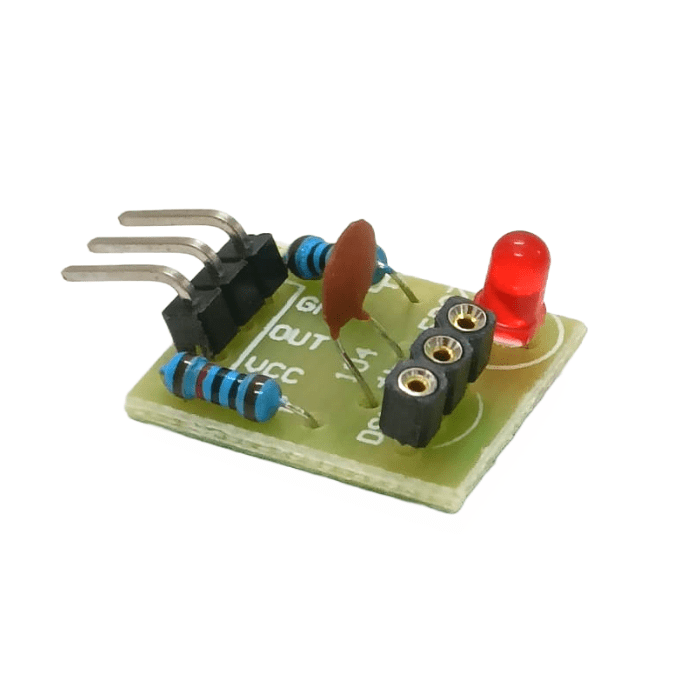Sort by
5mm LDR (Light Dependent Resi…
5mm LDR (Light Dependent Resistor)
A 5mm LDR photoresistor sensor is made of a high resistance semiconductor. If light falling on the device is of high enough frequency, photons absorbed by the semiconductor give the bound electron enough energy to jump into the conduction band. The resulting free electron (and its hole partner) conduct electricity, thereby lowering resistance. A photoelectric device can be either intrinsic or extrinsic. An intrinsic semiconductor has its own charge carriers and is not an efficient semiconductor, for example, silicon.
In intrinsic devices, the only available electrons are in the valence band, and hence the photon must have enough energy to excite the electron across the entire bandgap. Extrinsic devices have impurities, also called dopants, added whose ground state energy is closer to the conduction band; since the electrons do not have as far to jump, lower energy photons (that is, longer wavelengths and lower frequencies) are sufficient to trigger the device. If a sample of silicon has some of its atoms replaced by phosphorus atoms (impurities), there will be extra electrons available for conduction.
This is an example of an extrinsic semiconductor. Photoresistors are basically photocells. Sensitivity The sensitivity of a photodetector is the relationship between the light falling on the device and the resulting output signal. In the case of a photocell, one is dealing with the relationship between the incident light and the corresponding resistance of the cell.
Applications:
Camera Exposure Control
Auto Slide Focus
Photocopy Machines
Colorimetric Test Equipment
Automated Rear View Mirror Digital
Automatic Headlight Dimmer
Night Light Control
Street Light Control
Read our blog explaining how LDR works, detailing what is an LDR, how LDR Works in Street Lights, what are the types of LDR, how to make an LDR Sensor Module and applications of an LDR Sensor.
Package Includes:
5mm LDR (Light Dependent Resistor)
Specification:
Max Voltage
150 Vdc
Max Power
100mW
Spectral Peak
540nm
Light Resistance at 10Lux
20-30 Kohm
₹15.83
₹19.79
Incl. GST
650nm 6mm 5V DC Mini Laser Do…
Mini Laser Dot Diode Module
This 650nm 6mm mini laser diode module diode with integrated driver and be driven from 3.0V to 5.0V DC so they’re great for your embedded electronics project, robot or other application. This mini laser diode module is manufactured with copper plastic. It needs a 3 to 5VDC power supply and has a wavelength of 650nm.
This type of laser diode module typically includes a laser diode, a collimating lens, and a driver circuit that controls the power and modulation of the laser. The collimating lens is used to focus the laser beam into a small, intense dot.
It delivers superior power efficiency compared to competing products so whether working on intricate or delicate projects there will be minimal energy waste here; when every bit counts then these savings add up quickly over duration of use too - great news both financially and environmentally speaking! The highly accurate beam allows users fine control with greater precision than ever before as well thanks again due largely in part because of how faithfully each line follows another from start finish creating awesome results overall.
This laser sensor module is commonly used in a variety of applications such as pointing, alignment, positioning, and machine vision systems, in addition to other applications that require a visible red laser dot. It is also used in some laser pointer, laser level, and laser alignment tools.
Package Includes:
1 x 650nm 6mm 5V DC Mini Laser Dot Diode Module
Specifications:
Working Voltage
5V
Material
Copper
Output Power
5mW
Wavelength
650nm
Working Life
more than 2000 hours
Cable Length (cm)
7cms
Dimensions
6×10mm
Weight
5 grams
₹19.22
₹24.02
Incl. GST
7.5V/1.3W (BPL) Solar Panel
7.5V/1.3W (BPL) Solar Panel
A 7.5V/1.3W (BPL) solar panel converts solar power to electrical energy. The solar panel has a maximum output power of 1.3W and maximum output voltage of 7.5V. The most prevalent solar cell technologies are monocrystalline, polycrystalline, and amorphous BPL.
The solar panel is made up of solar cells that are linked in series and parallel to increase voltage and current.A solar cell is a device that converts light energy into electrical energy in photovoltaic energy conversion.
Solar cells are generally classified into four generations depending on time and the categories of materials that are used for their fabrication.
Package Includes:
1 x 7.5V/1.3W (BPL) Solar Panel
Specifications:
Output Type
Single
Voltage Rating
7.5 DCV
Power Rating
1.3 W
Working Temp(C)
-25 to +100
Dimensions
180 x 90mm
Weight
10gm
₹247.59
₹309.48
Incl. GST
APDS 9960 RGB And Gesture Sen…
APDS 9960 RGB And Gesture Sensor
The APDS 9960 RGB And Gesture Sensor is the RGB and Gesture Sensor, a small breakout board with a built-in APDS-9960 sensor that offers ambient light and color measuring, proximity detection, and touchless gesture sensing. With this RGB and Gesture Sensor you will be able to control a computer, microcontroller, robot, and more with a simple swipe of your hand! This is, in fact, the same sensor that the Samsung Galaxy S5 uses and is probably one of the best gesture sensors on the market for the price.
The APDS-9960 is a serious little piece of hardware with built-in UV and IR blocking filters, four separate diodes sensitive to different directions, and an I2C compatible interface. Each APDS-9960 also has a detection range of 4 to 8 inches (10 to 20 cm)
Pinout:
VL (optional power to IR LED)
GND (Ground)
VCC (power to APDS-9960 sensor)
SDA (I2C data)
SCL (I2C clock)
INT (interrupt).
Application:
RGB Infrared Gesture Sensor
Motion Direction Recognition Module
Package Includes:
1 x APDS 9960 RGB And Gesture Sensor
1 x 6 Pin Male Header
Specification:
Input Supply Voltage (VDC)
3.3
Communication Interface
I2C
Operating Range
4-8inches (10-20cm)
Dimensions
20x15x3mm
Weight
5g
₹214.81
₹268.51
Incl. GST
Color Recognition Sensor Modu…
Color Recognition Sensor Module TCS3200D/TCS2300
The TCS3200 Color Recognition Sensor Module uses a high-quality light sensor allowing you to sense any color through a combination of Red, Green, and Blue. The module provides all of the pins of the TCS3200 on convenient 0.1″ headers – ideal for use with PCBs, breadboard or stripboard.
Four white LEDs provide plenty of light for the color sensor and allow you to use the module in any ambient light.
The sensor module requires only a single supply voltage between 2.7V and 5.5V – making it compatible with nearly all common microcontrollers, including PICs, AVRs, ARM,Arduino and more.
Header one on the left side of the board
S0: Output frequency scaling selection input (along with S1)
S1: Output frequency scaling selection input (along with S0)
OE: Output Enable – if held low, the output of the module is turned on
GND: Ground – connect to 0V
Header two on the right side of the board
S3: Photodiode type (along with S2)
S2: Photodiode type (along with S3)
OUT: Output – A square wave appears here showing the intensity of the detected colour
VCC: Power – connect to 2.7V-5.5V
Package Includes:
1 x TCS3200D/TCS230 Color Sensor
Specifications:
Operating Voltage
3V-5V
Sensor Type
Color Sensor
Dimensions
3 x 2 x 1cms
Weight
5 grams
₹387.78
₹484.73
Incl. GST
Colour Sensor
Colour Sensor
A colour sensor is a device that detects and measures an object's or surface's colour. Color sensors measure the amount of light reflected or transmitted by an object in various wavelength bands. RGB (red, green, blue) sensors detect the intensity of light in the red, green, and blue areas of the spectrum, whereas CMYK (cyan, magenta, yellow, black) sensors measure the intensity of light in the cyan, magenta, yellow, and black regions of the spectrum.
White light is a mixture of three basic colors known as primary colors. They are red, blue and green. These colors have different wavelengths. Combinations of these colors at different proportions create different types of colors. When the white light falls on any surface, some of the wavelengths of the light are absorbed by the surface while some are reflected back based on the properties of the surface material.
Colour of the material is detected when these reflected wavelengths fall on the human eye. A material reflecting wavelengths of red light appears as red. The component used to detect colors is the Color sensor.
What is a Color Sensor?
A color sensor detects the color of the material. This sensor usually detects color in RBG scale. This sensor can categorize the color as red, blue or green. These sensors are also equipped with filters to reject the unwanted IR light and UV light.
Working Principle of Color Sensor
To detect the color of material three main types of equipment are required. A light source to illuminate the material surface, a surface whose color has to be detected and the receivers which can measure the reflected wavelengths.
Colour sensors contain a white light emitter to illuminate the surface. Three filters with wavelength sensitivities at 580nm, 540nm, 450nm to measure the wavelengths of red, green and blue colors respectively.
Applications:
Ensures accurate color in printing and packaging processes.
Checks color consistency in food to maintain product quality.
Matches colors in fabric and yarn production.
Adjusts colors in cameras and displays for better images.
Helps robots recognize objects based on color for automation.
Matches colors in fabric and yarn production.
Package Includes:
1 x Colour Sensor
Specifications
Input voltage
DC 3V-5V
Output frequency voltage
0 ~ 5V
Best detection distance
1cms
Dimensions
3 x 2 x 1cms
Weight
5 grams
₹421.70
₹527.12
Incl. GST
GY-302 BH1750 Light Intensity…
GY-302 BH1750 Light Intensity Module
The GY-302 BH1750 Light Intensity Module is a Light Intensity Detection Module based on the BH1750 chip. BH1750FVI is a digital Ambient Light Sensor IC for the I2C bus interface. This IC is the most suitable to receive the ambient light data for adjusting the LCD and Keypad backlight power of the Mobile phone. It is possible to detect a wide range at High resolution.
read our blog explaining How ldr sensors Works, provides comprehensive information about Light Dependent Resistors (LDRs), including their working principle, types, applications, and DIY projects.
GY-302 BH1750 Light Intensity Module Pinout:
Applications:
Can be used in DIY Projects to measure light intensity
Can be used in Digital camera
Can be used in Portable game machine
Can be used in LCD display
Package Includes:
1 x GY-302 BH1750 Light Intensity Module
Specifications:
Type
GY-302
Operating Voltage (VDC)
3 ~ 5
Analog to Digital Converter
Build-in 16-bit
Interface
I2C
Date Range
0~65535
Dimensions(LxWxH)
18 x 13 x 3 mm
Weight
0.10gm
₹94.97
₹118.71
Incl. GST
KY-010 Broken Light Blocking …
Y-010 Broken Light Blocking Sensor
The KY-010 Photo Interrupter module consists of an optical emitter/detector in the front and two resistors (1 kΩ and 33 Ω) in the back. The sensor uses a beam of light between de emitter an detector to check if the path between both is being blocked by an opaque object.
KY010 Sensor Connection Diagram
Connect the power line (middle) and ground (left) to +5V and GND respectively. Connect signal (S) to pin 3 on the Arduino.
- (left)
GND
middle
+5V
S (right)
Pin 3
Package Includes:
1 x KY-010 Broken Light Blocking Sensor
Specifications
Model
KY010
Sensor Type
Broken Light Blocking Sensor
Operating Voltage
3.3 ~ 5V
Dimensions
18.5mm x 15mm
Weight
5 grams
₹44.08
₹55.11
Incl. GST
Laser Module
Laser Module
A laser module is a device that produces a highly focused beam of light, usually in the visible or infrared range. A laser diode, a power supply, and a focusing lens are typical components of a laser module. A laser diode is a semiconductor device that emits a light beam when current is supplied through it.
The Laser Sensor Module is composed of a light-emitting tube, condenser lens, and adjustable copper sleeve and it is assembled when delivered, the focal length of the lens is adjusted glued by strong glue stick, which can work directly after connecting to a 5V DC power supply.
Pay attention to the laser cell to prevent from being burnt or battery explosion due to a short circuit when removing the battery.
The Laser Module is an advanced, easy to use tool that offers users a wide range of applications and functions. This high-tech device makes it possible for the user to control lighting levels and colours in their interior or exterior space by converting electrical signals into soundwaves which can be manipulated accordingly.
The module has been designed using robust components backed with reliable technology specifically made for precise performance even under challenging conditions like low-temperature environments or dusty locations making them ideal for industrial settings. Moreover, its compact size allows users to carry it around easily wherever they go providing precision-regulated power output every time without any downtime worries ensuring complete reliability at all times regardless of whatever environment you might find yourself operating in!
check out : 650nm 6mm 5V DC Mini Laser Dot Diode Module
Pinout:
1 – GND
2 – 5V
3 – S (Control: HIGH = Laser on)
Applications:
Laser test tools.
Concentricity positioning.
Medical equipment positioning.
Production of signal equipment.
Use for DIY or robots.
All kinds of level meters.
Laser projector.
Laser toys, etc.
Package Include:
1 x Laser Module
Specifications
Voltage
3.0 V – 5 V
Driver
APC circuit
Line length
about 135 mm
Operating Current
40mA
Transmit power
58mW
Dimensions
3 x 2 x 1cms
Weight
5 grams
₹36.18
₹45.23
Incl. GST
Laser Receiver Module
Laser Receiver Module
LASER lights have many applications like in counting, time measurement, laser guidance systems etc. It is very vital to correctly read and perform the corresponding function given in your code as any misread or malfunction in system can lead to fatal errors and losses to company. To keep this error in check this Non- Modulator Tube LASER Receiver sensor module is there to help you read the incoming laser signals accurately. It gives output of laser receiver in digital format and output pin is high when LASER is detected and low when LASER is not detected. This module works on 5V Voltage input and due to its small size you can use it in portable devices and industrial equipment.
This Laser Receiver Sensor Module Laser output High Level is a sensor for Raspberry Pi and Arduino to receive the laser output and decode it digital data. At Input, the module Receives a laser signal when output high level; Does not receive a laser signal when output low level. On detecting a laser signal, output goes at a high level (5V) until the laser signal is there.
Circuit diagram
As you can see the setup consists only one amber LED and its current limiter 10K resistor connected across the output of the module (OUT & VCC).
₹73.48
₹91.85
Incl. GST










